Northway Bus Station Scarborough
Northway Bus Station Scarborough
The recent discussions about Scarboroughs Westwood Bus Station reminded me that, in the early fifties when my family often visited relatives in Newby an area just out side Scarborough. At the time East Yorkshire Motor Services used the Northway Bus Station which was shared with the West Yorkshire Road Car Co. Here are three photos which, I hope, give an impression of the station. Although all three show the buses not at the stand such were the number of duplicates that these occupied the edge of the station with others taking the platform side.
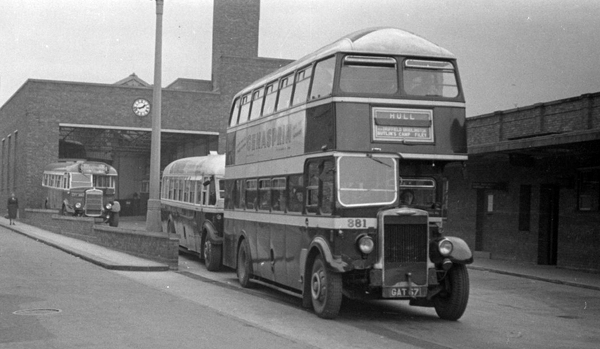
381 - GAT 67 Leyland Titan TD5 with an ECW HBB26/26R body new in 1939
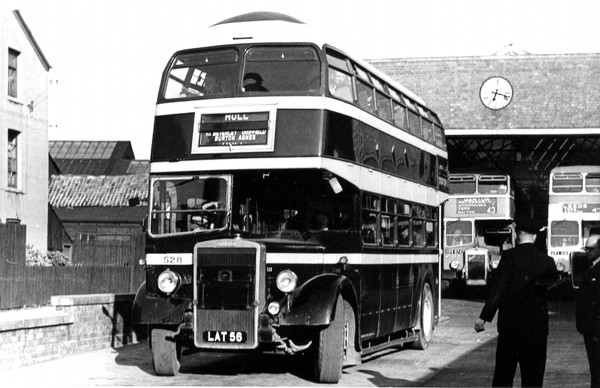
528 - LAT 56 Leyland Titan PD2/3 with a Roe HBB20/26R body new in 1950
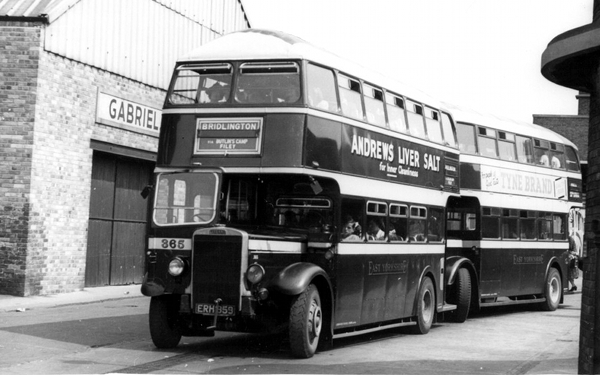
365 - ERH 359 Leyland Titan TD5 with an ECW HBB26/26R body new in 1938
In addition to the East Yorkshire buses the West Yorkshire part of the site shows a single deck (with bible indicator) and double deckers including no.751 which at one time was a 41 seat coach until being converted back to 55 seat in 1952.

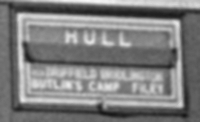
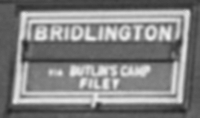
528 blind 381 blind 365 blind
No. 528 is displaying the blind for Hull-Bridlington journeys rather than the Hull-Scarborough version - compare with no. 381 - and the Bridlington-Scarborough version displayed by no. 365.
No. 528 was my favourite East Yorkshire bus and was one of what was probably the best looking Beverley Bar buses, the twenty-four Leyland PD2/3s (nos. 527-550) which entered service in late 1950, the last (nos 547-550) being withdrawn in 1967.
We completed our journey to Newby by Bristol L on service 116 from United's Valley Bridge station to which East Yorkshire eventually graduated.
All the photos are from my collection but no photographer's name is recorded.
Malcolm J Wells
04/2012
21/04/12 - 08:46
Three magnificent pictures of the bus station with many mobile "stars" to relish. On the theme of "Desert Island Discs" the EYMS ECW rebodied TD5s have me drooling still and I should have to take one of those to the Island. How many folks have noticed another unique (literally) star in the centre picture. It is no less than West Yorkshire Road Car K6B 751 (later DB23) GWX 108, which was converted when new and before entering service into a double decker coach. This was done to the usual WY perfection at Grove Park Works, Harrogate and the vehicle was finished in the coach livery of rich cream and glorious maroon and was fitted with coach seats and platform doors. It performed primarily on service 43, Bradford - Leeds - Scarborough for many years before eventually being demoted to bus work in normal red livery, although retaining the platform doors.
Chris Youhill
21/04/12 - 14:27
The Northway photos had me drooling too, Chris, as I especially loved the ECW TD5s. Something about the Beverley Bar variation to the attractive lines of ECW bodywork, dressed up in a "non Tilling" livery. Not sure about the Desert Island though, I would rather have the pre-war L which is lurking in the background of the top photo.
I had a very soft spot for the EYMS of this era, as I was a regular traveller from Bridlington to Skipsea where the Roe PD1s were regulars. There was something very specific and different about East Yorkshire, which, in my boyhood, translates into an awareness of oval rear window saloons, and 3 window fronted double deckers, features which were totally unknown by myself, all of which was enhanced by the "Beverley Bar" top decks, and that beautiful unique livery. Wonderfully evocative photos, and the destination points come flooding back to my mind.....Barmston, Beeford, Skipsea, Atwick, Cayton Bay, Butlins Camp. Oh Happy Days!!
On another of your points, if todays operators used equally dignified liveries, perhaps I would have a bit more interest in the modern scene, my interest having evaporated at about the time of the start-up of NBC!
John Whitaker
22/04/12 - 07:38
No need to fear John - don't forget you can take your eight favourite discs, or buses, to the Desert Island so you can have the TD5, the L5G, and another six beauties, so thinking cap on and select your other half dozen favourites.
Chris Youhill
25/04/12 - 05:24
Recent postings have prompted me to ask whether anybody can give a complete history of the three Scarborough Bus Stations?
West Yorkshire at one time shared Valley Bridge with United (pre war) and possibly returned there after Northway closed but I hadn't realised that East Yorkshire shared Northway (which I assume was owned by West Yorkshire and appears to have doubled as a Depot) with West Yorkshire before moving to Westwood. The Railway Station area now serves as a Bus Station.
Two Prestige Series books (One on United and one on West Yorkshire) contain many excellent photographs by Geffrey Atkins at Valley Bridge (which still survives as a car park) and at Northway which has been demolished and re-developed.
One last point - I assume that the Scarborough - Bridlington services (which started from different points) ran in competition and were not jointly operated.
Gordon Green
09/02/13 - 07:19
A number of contributors mention three bus stations in Scarborough namely Westwood, Valley Bridge and Northway. Actually there have been quite a number of other locations. EH Robinsons were in Aberdeen Walk (in addition to the Station Yard), East and West Yorkshire leased another Robinsons premises in Vine Street (now Duggleby’s) before moving to Northway, United were in Vernon Road which is now the Palm Court Hotel garage before moving to Somerset Terrace and Hardwick’s were in Victoria Road. In addition to which Appleby’s and Wallace Arnold had premises in the town.
Chris Tinker
13/02/13 - 05:33
I have had a thing about Northway since using the bus station after a run across on LWR 417, DBW 31 the flamboyant double decker coach which took over from the K6B in 1953. I attach some photos which will be of interest.
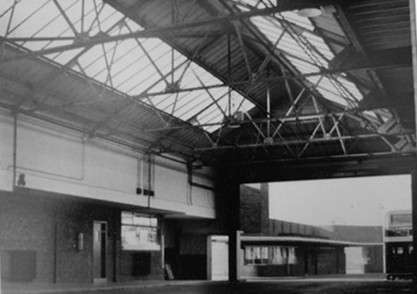






The black and whites I think are official photos and the two coloured ones I took in 1996 when re-visiting Northway, or what was left of it. Just look at the clock face on the garage end, which had been left in situ, though broken. I understand that the site has now been completely cleared and redeveloped. In 1996 I managed to purchase a full set of architects’ drawings of Northway bus station (from the Council) with the intentions of building a model of it for my collection of scratch built EYMS and WYRCC models. I never got on with this project because I realised it would be huge. There was an article in “Buses” for October 1968 saying that Northway was up for sale because of dovetailing of services between WYRCC, EYMS and United. The article states that Northway was completed in 1939, although it was not until two years later that it was officially opened. The staff comprised (in 1968) one inspector, two clerks, nine drivers and three conductors. Four single deckers were garaged there throughout the year. It’s tragic that such an important piece of art deco architecture was just demolished. It was Scarborough’s loss.
David Rhodes
14/02/13 - 07:23
David, thank you for posting such wonderfully atmospheric photos. The roofing material, roof trusses, glazing panels and overall build are evocative of so many bus stations and garages of the period, as indeed is the Art Deco exterior. I agree with you wholeheartedly that it is sad Scarborough Council sanctioned its demolition. Unfortunately many such 'local landmark' buildings, big and small, have been lost since the privatisation and deregulation shenanigans of the late '80s, but such things cannot be blamed in the case of Northway.
Brendan Smith
14/02/13 - 11:04
David - thank you for posting these photos - I had never seen Northway but I have recently tried by way of Google to place it in relation to the new development and surviving buildings. I think I have been to a great extent successful but I would welcome some clarification.
It seems that the garage and departure stands operated on a 'through way' system - from which street did they enter and which street did the departure stand lead onto.
Is it my imagination or is the large overhanging clock of the same design as the one that adorned Harrogate Bus Station ? - perhaps it was 'BOGOF' !
Gordon Green
15/02/13 - 06:50

In reply to Gordon’s queries, yes, Northway operated as a one way system. Vehicles either entered through the garage doors or the middle entrance to the stands in Northway. They exited through Brook Street and then Trafalgar Street. The architects on the plan is H.J. Starkey, 15 Curzon Street, London W.1. dated March 1939. These drawings can be bought from Scarborough Borough Council if anybody is interested. Incidentally, it should be possible to buy architects’ drawings of any buildings or developments which were lodged after mid-1930s (not sure of the exact year) with the relevant local authority planning department.
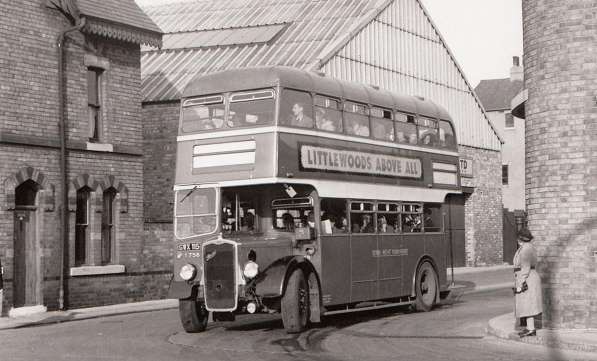
This photo of the Highbridge K Type was taken on the junction of Brook Street and Trafalgar Street exit. Copyright John Fozzard.
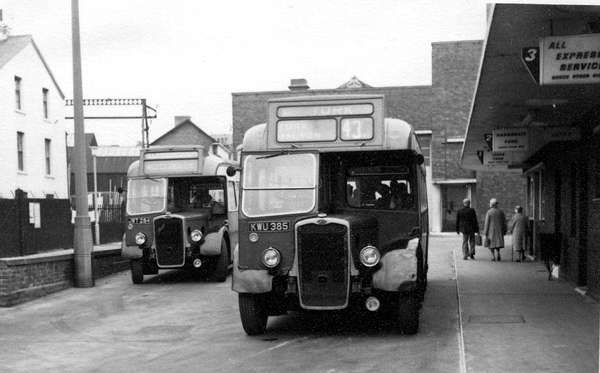
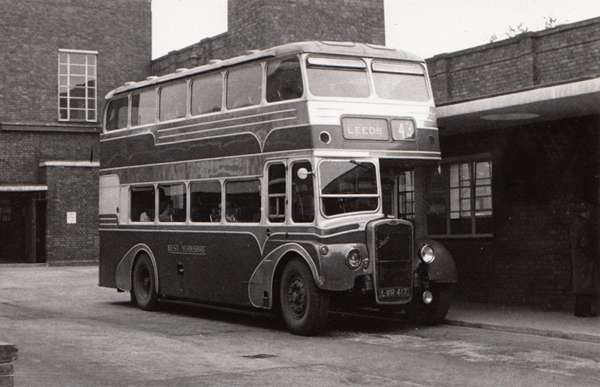
The two photos above of (SBW 25 and SG 135) and (WYIS LWR 417) shot in the station were taken by myself.
David Rhodes
15/02/13 - 12:09
What wonderful photos have been encouraged by this topic. The last two by David Rhodes are of particular interest to me, although not actually in the Scarborough connection.
When I worked at WY Ilkley depot we had three of the magnificent LWL6B class, including SBW 26 (and 17 and 33). In my view these, and their 7'6" wide companions, were among the finest front engined single deckers ever produced, both in attractive exterior appearance and in skilfully arranged interior space and passenger flow.
I rarely if ever find any fault with WYRCC's projects but, oh dear, the coach converted KSW in the picture must surely be the one mistake that anyone is allowed to make !! As if the "jazzing up" of such a dignified vehicle wasn't bad enough, the totally incongruous and amateur looking mouldings, "portholes" and chrome pieces are quite unforgivable. Also, in view of its chief use on the 43 Bradford - Leeds - Scarborough service the lowbridge layout is quite unacceptable in upper saloon visibility terms. The same drawback could be levelled at 751 (DB23) but at least that was magnificently and beautifully finished externally in the standard maroon and cream coach livery and "looked a picture."
Chris Youhill
15/02/13 - 15:36
Do I take it, Chris Y, that a lowbridge vehicle was unnecessary on the Bradford-Leeds-Scarborough route, then?
At first glance, I wondered what a Barton Transport vehicle was doing on this post! And could we have a photo of the other vehicle you mentioned, namely 751 (DB23), please? I'm intrigued.
Chris Hebbron
16/02/13 - 07:34
As far as I know Chris H there was no need at all for lowbridge buses on service 43 - the position was simply that all vehicles, as far as I can recall, were from Leeds depot (and possibly Bradford) neither of whom had highbridge vehicles.
I have no pictures immediately to hand of 751/DB23 - I will look for one - but it can be seen in one of the first pictures of this topic, inside the garage to the right of the doorway.
Chris Youhill
16/02/13 - 07:36
I must say thanks to David for sharing his plan of the site - it's enabled me to put everything together . . . except for one thing! On the second photograph in David's post of 13/02 there's an area cordoned-off behind some roller doors - shown in the top right-hand corner of the plan submitted 15/02 . . . what does it say on the plan? inspection pit?? Whatever that facility was I just can't see how a bus would have accessed it through those internal doors: but look at the seventh photograph down on 13/02 - doesn't that seem to show a blocked-up opening from Brook St to this area? . . . except that there's no entrance there shown on the plan.
Philip Rushworth
16/02/13 - 07:37
Incidentally, what are the two 'patches' on the front dome of the KSW - are they glazed, or what?
Aside from that, there's certainly plenty of roof ventilation up there!
Chris Hebbron
16/02/13 - 07:39
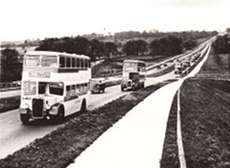
Someone asked whether there was a photograph of the other West Yorkshire double decker coach. Here it is c. 1951 heading a convoy of other West Yorkshire deckers on what I guess is the A64 heading back from the coast. I do have other photos in my collection, but don’t want to trip up on copyright. On this photo copyright was held by the WYIS.
Sorry Chris Youhill that you find DBW 31 so offencive. I think a lot of people do, but looks are very subjective and because of my early associations with the vehicle I actually quite like it. As a piece of design it is odd and somewhat over the top, but I think it shows a confidence from the company. It’s a statement of the company’s belief in itself. Like a ‘59 Cadillac, it’s over-egged styling but you can’t miss it. I used to try and seek it out every time I went to York or Scarborough. Sadly, it was withdrawn very early compared with the other KSWs because it was awkward for ordinary stage carriage service because of the high back seats. Taking fares upstairs must have been a nightmare. Does anyone have any photographs of it after it had been sold by West Yorkshire?
David Rhodes
16/02/13 - 09:03
There are some excellent photos and pieces of information from contributors to this topic. I first visited Scarborough in 1970 so just missed seeing Northway Bus Station in action but I've wandered round the area at various times trying to work out how it all operated.
H.J.Starkey was the architect for the Tilling Group (I think 15, Curzon Street was the Tilling head office) and his designs could be seen wherever there were Tilling Group buses although sadly many are now demolished.
Gordon Green thinks the clock looks like the one at Harrogate but I think it looks like the one at Norwich Bus Station so Mr. Starkey must have ordered a job lot, I guess.
As the part owner of a KSW, I know what Chris Youhill means about the visibility from the top deck of a lowbridge bus. You actually get a better view from the second row back than from the front seats.
Nigel Turner
16/02/13 - 11:17
May I echo Philip's thanks to David for this comprehensive information in answer to my enquiry. It has answered all the questions I had about Northway. I just have one unanswered question from my April comment, was the Bridlington route jointly operated by EYMS/UAS or were they in competition?
Gordon Green
16/02/13 - 14:37
Thx, David R, for the photo of DBW 31 speeding along. Judging from the small photo, the different livery makes this bus look better than the other one.
And thx for your contribution which has enlivened the topic once again.
Chris Hebbron
16/02/13 - 14:38
I don't recall ever suffering the poor visibility from upstairs on a low-bridge Bristol K as an adult. It was fine for a little lad (age 8-10). I loved that front seat upstairs. In those years we holidayed at Penzance, and Western National retained 7ft 6in wide lowbridge Ks (usually K6Bs, but a few K5Gs) on most routes in the area, owing to the narrow roads. The journey from St Ives to Penzance on the long route 14 (coast road to Gurnards Head, and then the narrow unclassified lane across the moor to Penzance) was an absolute delight, both for scenery and sound effects.
Stephen Ford
16/02/13 - 14:44
David, I am almost certain the print you show was taken at the bottom of Whitwell Hill and was originally a company shot of the 1:30pm Saturday departure from Scarborough to the West Riding (Keighley/Bradford/Leeds) 43 service during the official town holidays in July/August, when numerous duplicates were operated during this busy period. This would have been in about 1951/2.
David Allen
16/02/13 - 16:58
In the 1950s and 1960s the Brdilington - Scarborough services were different. The EYMS service 12 did not serve Hunmanby but United's 111 did. They were not coordinated and the 111 started from valley Bridge bus station and terminated/started from a small turning circle diagonally opposite the EYMS bus station in Bridlington.
Malcolm Wells
17/02/13 - 07:31
In answer to Gordon's question about Scarborough-Bridlington operations, and further to Malcolm's response, prior to 27th May 1967 UAS and EYMS both operated independently over this route: UAS as 111 Scarborough-Bridlington, and EYMS as 12 Scarborough-Bridlington-Hull (with short-workings between Scarborough-Bridlington) - although from what I can make out both had several variations in routing between Filey and Bridlington (as later service numbers seem to bear out). The EYMS service used Northway, and later Westwood, bus station in Scarborough and their - the principal - bus station in Bridlington; whilst the UAS service used, as Malcolm wrote, their facilities in those towns [see question below]. From 27th May 1967 the operations between Scarborough-Bridlington were coordinated: it had been agreed by the Traffic Managers of the companies that service numbers 120-124 would be used, but the EYMS GM "Cosmo" Wreathall insisted that the trunk Scarborough-Bridlington-Hull route remain 12, and so numbers 120/3/4 were used for the various routings of the Scarborough-Bridlington short workings. Now I've got some questions . . .
Firstly. Until the coordination agreement UAS had maintained a bus station (although Malcolm's description makes that seem rather a generous use of the term!) and a two-bus outstation in Bridlington - does anybody know where the UAS outstation was?
Secondly. By the time I was visiting Bridlington regularly-ish, from 1980, UAS buses were no longer in evidence - does anybody know when UAS withdrew from the Scarborough-Bridlington route?
Thirdly. I assume that when EYMS-UAS coordinated their operations the Scarborough terminus was rationalised at UAS's Valley Bridge premises. I know that in NBC days the EYMS Westwood site was transferred to UAS and used as a coach station/park . . . but what use did EYMS make of it between 1967 and its transfer to United, and for how long did the platform buildings remain standing?
And fourthly, to bring us back to Northway. Why did EYMS move out of Northway and establish their own bus station at Westwood? Suggestions . . .
Philip Rushworth
17/02/13 - 07:32
If I may digress slightly from the subject of the thread, I would agree that the photo posted by David R of the A64 was indeed of Whitwell Hill as suggested by David A. It was obviously taken with a long lens and I suggest that as the two buses in the foreground appear to be on a rising trajectory, they would have just passed the now deadly Barton Hill Crossroads and be approaching the bridge over the York to Scarborough railway line.
As an aside, can anybody tell me please when the dual carriageway section between the Spitalbeck pub (now a Pakistani restaurant) and the Cranbeck Village was built; (The villages of Barton Hill and Whitwell on the Hill being bypassed in the process). I suspect it was just before WW2 but have no evidence of this. Also, those with long memories may recall the three lane sections of the A64 between roughly York and Malton with the road signs proclaiming 'Keep to nearside lane except when overtaking'. I think these sections were hastily removed probably in the early 60's when traffic levels and higher speeds rendered the instructions lethal and the sections involved were replaced with a single lane each way.
John Darwent
17/02/13 - 08:55
Just a slight clarification Malcolm if I may - as far as I recall the United facility on Bridlington Promenade was actually the forecourt to their shop/offices. The latter building remains as a cafe with a few "alfresco" tables and chairs outside for the hardier customers. I can't recall any United "outstation" premises in Bridlington - I may well be wrong - but is it just a possibility that the vehicles concerned slept at the EYMS depot, or would that be pre-empting cooperation just a little ??
Chris Youhill
17/02/13 - 11:35
The garage for the UAS buses (2) was in the railway stn yard at Bridlington and was passed on the way out on route as the service left town via Bridge St Windsor Cres and through stn yard to Quay Rd going out of town via various routes/villages to Filey/Scarbro.
Ken Wragg
17/02/13 - 13:30
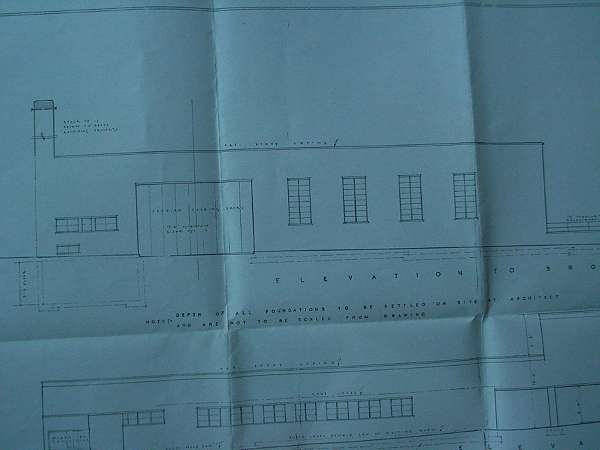
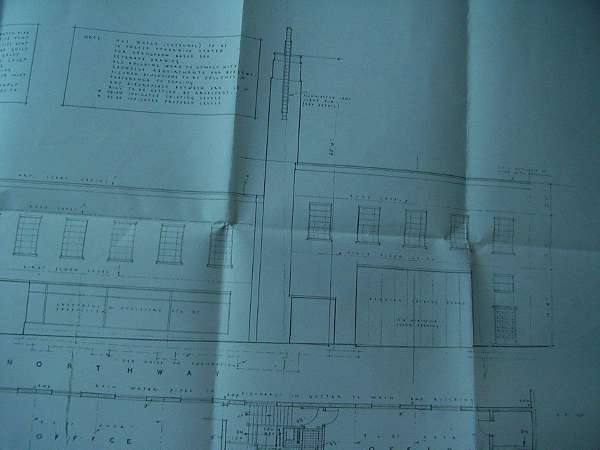
Back again! To try and clarify the layout of the Northway Garage, I have photographed parts of the architect’s drawings. I have shown two elevations, one from Brook Street and one from Northway.
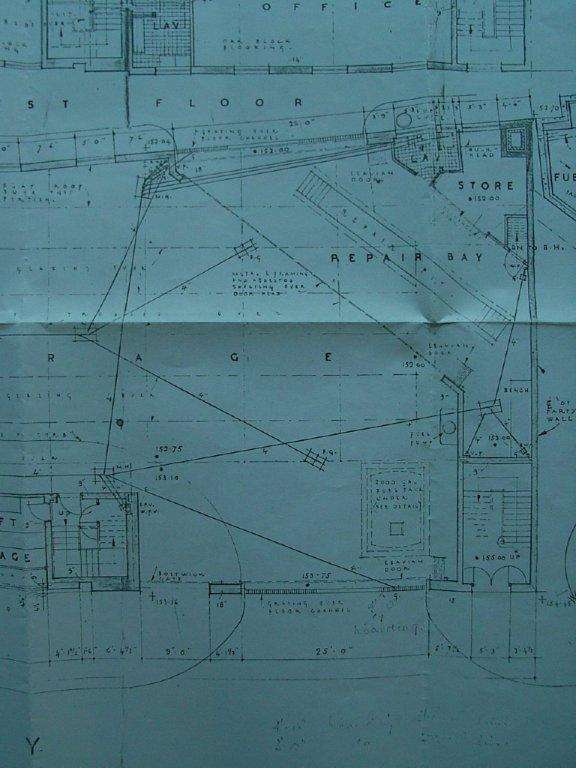
This is a ground floor plan of the garage which Philip was asking about. You can clearly see the angle of the partition doors which separated the main part of the garage from the service bay.
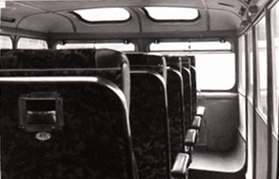
The patches on the roof of DBW 31 were fixed skylights. I think there were six in all. The photo of the interior of the bus gives a good idea of the problem caused by coach seating in the Lowbridge. This is copyright WYIS.
David Rhodes
18/02/13 - 08:42
Ah ha! The more detailed drawings posted by David do show an entrance to the repair bay from Brook Street. I will sleep tonight. But all this infrastructure for one route and 4 buses . . . although the rental income from the first-floor offices - I'm assuming that since access appears to have been by a separate entrance they must have been let commercially - might have offset the costs to some extent.
And thanks to Chris and Ken for clarifying UAS's position in Scarborough.
Philip Rushworth
18/02/13 - 11:04
Thx, David, for the photo clarifying the glazed roof of DBW31.
Chris Hebbron
19/02/13 - 06:13
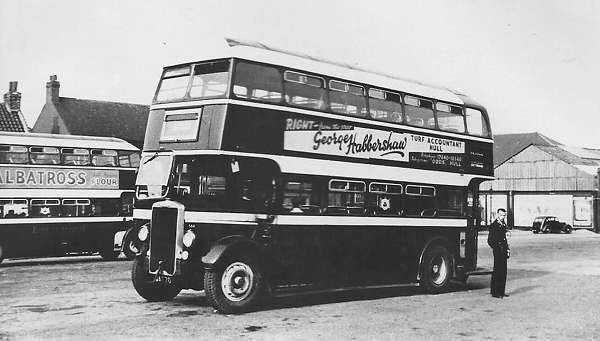
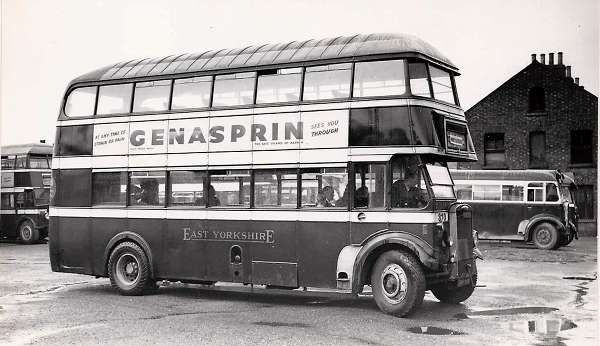
I have been following the postings on Northway bus station with interest, with all the photos, maps and plans it just about covered everything, but-I have several photographs of EYMS vehicles parked at Northway but they are not in the bus station but seem to be on waste land, there are WYRCC buses also parked up, was this an overflow parking area? for busy summer weekends, if so where was it in relation to the bus station, on some photos shops on Northway can be seen in the background. Its not before bus station was built as I have views of later buses parked there.
Mike Davies
19/02/13 - 06:13
David, I must say the photo of the top deck interior of DBW 31 brought back some memories!
I always thought it was a garish monstrosity, and most "un-Tilling-like", but beauty is in the eye of the beholder.
We regularly used the Leeds/Bridlington joint EYMS service, but never got anything "posher" than a service bus, and usually a pre war L at that, but that suited me fine.
I am intrigued, as a former WYIS member, about the photos origin. Is it possible for you to say, David, whether there is a WY photo collection available for sale? Especially the pre war fleet.
If so, could you pass on contact details, as I have been searching for years in a bid to fill out my collection.
John Whitaker
19/02/13 - 17:11
John - WYIS no longer exists as far as I know and again, as far as I know, all the negatives from their photo collection (most of it ex-Bob Mack) have gone to the Omnibus Society, but I'll stand corrected if anybody knows better. It is a great shame that they are no longer for sale, but I think the whole business was getting too much to handle. John Fozard runs a photo sales on ebay and usually there are a few shots for grabs on there. Other than that, there's an extensive West Yorkshire photo collection (which is ever-increasing) to view on Flickr.
I was very pleased to see some more input on the Northway topic and I particularly like those EYMS Leylands. I have other photos of buses parked on some land at Northway, but my memory fails me on this one. I can't remember where it was in relation to the bus station.
Again, has anybody any photographs of the DBW 31 coach after it was sold? It went to serve as transport for a bingo or variety club in the Batley area but I've never seen any photographs of it in this role.
Very pleased that Northway is getting some interest and recognition.
David Rhodes
20/02/13 - 05:53
All the Northway bus station items are most fascinating - I missed them when they were first added to the site and it was only when I followed the most recent posting that I found them!
During my childhood (1950s) my Grandparents lived a couple of streets away from the bus station so it always a treat to have to walk by when were out and about.
The parking ground Mike Davies queried which was put to very good use on Summer Saturdays in particular was in the 'V' of Northway and Trafalgar Street West. If you look at Google Streetview the site is where the former GPO/BT building was constructed (now Openreach). The buses leaving the bus station were facing the site.
In the 1960s my Grandad used to meet up with his old pals and they all used to sit in the bus station waiting room chewing the fat.
We would travel from Rochdale to Scarborough on the joint Ribble/West Yorkshire service X192 which originated in Liverpool. Sometimes it would be a Ribble Leyland Royal Tiger or sometime one of the West Yorkshire ECW bodied Bristol EUG 'express' class. I think I once read somewhere that the allocation of the Scarborough garage was 'formally increased' with the addition of one EUG class vehicle for the X192 service. Scarborough and Malton were sub-depots of York - vehicles of which were identified by a yellow disc adjacent to the fleet number.
The summer only X192 operated four days a week in the early season (Fri/Sat/Sun/Mon) but daily in the main summer months. There was also a St. Helens-Scarborough-St Helens on high season Saturdays.
I have posted a Summer 1956 timetable on Flickr which may be seen at:www.flickr.com/one
Turning to the Scarborough-Filey-Bridlington etc services. My two great aunties lived in Cayton Village and they were staunch supporters of the EYMS services - only using United if they absolutely had to! In the 1960s Cayton was served by the Scarborough-Filey-Hunmanby service 10/10A. The timetable also some Scarborough-Cayton 'shorts'. I never recorded which buses I rode on for these trips but remember travelling on both single and double deckers. Many years ago I bought some EYMS photographs from R H G Simpson of Oxford and (Great) Auntie Florrie can be seen sat on the front seat of one of the single deckers.
In order to share this picture, and some of the other buses Mr Simpson photographed in Scarborough in the 1950s era, I have added them on Flickr:www.flickr.com/two
Also on Flickr are some magnificent photos from the same era of the United, WYRCC and EYMS buses and I have 'Galleried' them for my own pleasure. Some are in and around Northway. There are two shots of United buses which show the edge of Northway bus station where Arundale's Shell filling station abuts it.www.flickr.com/three
David Slater
20/02/13 - 09:38
David Slater - Thank you very much for your contribution to this topic and for all the others on Flickr. What is so good about this exchange is the personal memories which bring life to the photographs etc. I only wish I had had more pocket money at the time, so could have taken many more photos of my own. I had 12 shots in the camera and it was three weeks' pocket money for the processing afterwards. Oh that we'd had digital then! The quality of your photography is wonderful - did you take these yourself? As a retired sign-painter, I am particularly taken by the sign on the shop front cafe which has a section of the sign painted Ribble Seagull coach on it. Does this feature in full view on any of your others? Was this in St. Helens?
The photos of the Lancs Municipal buses with all their different liveries reminded me of journeys from Yorkshire to Lancashire when I was a kid in pre-motorway days. Lancashire seemed all red brick for miles and miles, but you knew where you were because of the different liveries each town or city had. Sadly all this local identity and pride has been lost under corporate blunders.
David Rhodes
21/02/13 - 06:05
The black and white shots in the 'Galleries' I have saved on Flickr are unfortunately not my photographs so I cannot take the credit.
On Flickr it is possible for a person to honour other people's photographic work by bookmarking them as either a 'favourite' or in a 'gallery'. The gallery principle enables anyone to bring together 20 photographs of any subject from any Flickr contributor and store them in an organised way in one place. So all I have done is to bring together those magnificent shots which are particularly meaningful to me. The photographers usually have a lot more to offer and clicking the photographers name alongside the photo will often reveal more gems.
Despite the photo featuring the Burlingham Seagull sign not being my own I am able to answer your question about the location of the café. This property was on Great Bridgewater Street in Manchester across the street from the exit of Lower Mosley Station bus station (which is out of shot to the left of the photograph). The Ribble vehicles in the background were parked on the area also across the street from the main bus station itself. Today Jurys Inn Hotel appears to occupy most of the plot forming the background of the picture.
A complete picture of the sign can be seen in another photo on Flickr: www.flickr.com/photos/
David Slater
21/02/13 - 06:07
What a wonderful thread this has turned out to be. Lots of fascinating questions, but equally lots of fascinating answers. Philip's query relating to the inspection pit behind the large folding doors intrigues me as well. One wonders why the original Brook Street vehicle access was bricked up. Was it because Brook Street became much busier, making reversing onto or off the street more hazardous? The new internal access does look somewhat awkward in the picture, but in the hands of a skilled driver - and provided the doors could be opened fully without any central pillar - it could have been possible to reverse a bus in from the main garage and swing it carefully around onto the pit (after ensuring all pit grates were in situ of course!!).
Relating to WYRCC's DBW31, David's photo shows this 'larger than life' KSW6B in its later red and chrome livery with standard fleetname, as opposed to the original black and chrome scheme with 'chromed' fleetname. It also seems to have lost its nearside built-up front mudguard, which originally matched that of the offside, in favour of a standard one. In Keith Jenkinson's book on the history of West Yorkshire, the author states that "DBW31 was repainted into a less "flashy" livery, with the removal of all its chromed trimmings" in 1959. It is perhaps a shame that the Company did not persist with the double-deck coach idea a little longer, as the Lodekka would have made a better conversion, given its improved gangway layout and greater visibility for upstairs passengers. In my mind's eye, a simple cream and red 'express' livery with a hint of polished aluminium trim would have looked a treat on such 'EDX's'.
On an EYMS note, weren't the ECW rebodied Leyland Titan TDs handsome machines? The adaptation of the standard bodywork to take the Beverley Bar roof profile was very neat. Splendid effort.
Brendan Smith
21/02/13 - 15:26
In response to Brendan's last posting, as far as I can see on the original 1939 drawing the plan of the garage at Northway shows the pit, therefore I can only assume that the pit with its sliding separating doors was not a later addition.
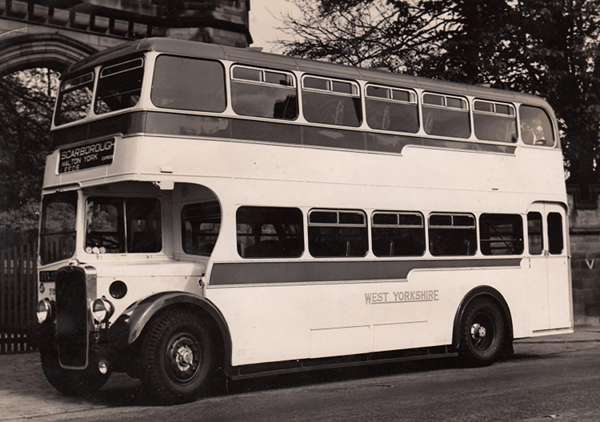
Also, here are a couple more pictures of the double deck coaches used on the Scarborough Express. I have just found this one of K6B no. 751, the first d/d coach. It's certainly a much more constrained design than DBW 31 was. The side flashes matched the d/p coaches of that time, and I think that's why this design looked right. The photo is an old official one. Not sure of the location.
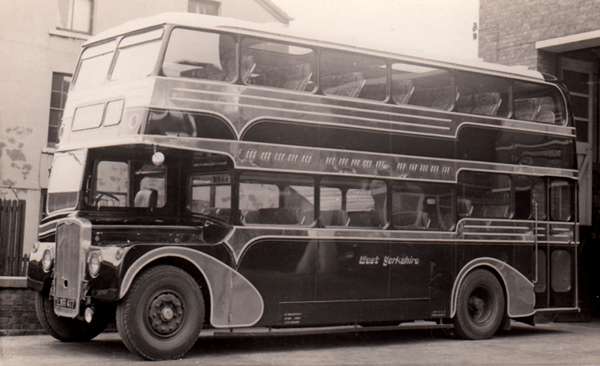
The photo of DBW 31 shows it in its original black and chrome with the built-up mudguards. It also clearly shows the location of the seats over the rear wheel arch, which necessitated the lift in the waistline at that point.
Incidentally, if you look at later photos, as the flashes were rendered unnecessary they seem to have been painted over, because the outlines can still be seen. Unless anyone else knows better, of course. I don't know who has copyright of this one because I bought it on a photostall at a rally a long time ago.
David Rhodes
21/02/13 - 17:35
A couple of days ago (17/02/13) Ken Wragg answered a question about the (2) bus depot of United AS at Bridlington.
I have a few questions about it, where abouts was it in the station yard, was it purpose built for United or did it come from an acquired Bridlington operator, when was it closed or demolished and any photographs of the depot or any more info??? not a lot there to answer!!
Mike Davies
22/02/13 - 06:18
Two points of wholehearted agreement here Brendan !!
I too would have love to have seen an "EDX", with perhaps luggage racks over one or both lower saloon rear seats, giving a seating capacity of 57 or 54. Or shall we go the whole hog and also enjoy some cream "CDX"s with maroon band between decks ??
The TD5/ECW beauties were definitely among my "desert island eight favourites" including those with standard ECW bodies as with east Kent, Ribble etc. I often wonder though if, when the Beverley Bar specification arrived at Lowestoft, calendars were hurriedly scanned to make sure it wasn't April 1st !!
Chris Youhill
22/02/13 - 09:51
David Rhodes' wonderful view of WY d/d coach 751, taken at an unknown location is, I'm pretty sure, standing at Cliffe Castle Gates, Keighley. Did WY operate a through Scarborough Express from there? The blind shows the intermediates of Malton, York and Leeds, which suggests it did. Could this have been the first run of this service using this splendid coach? What a treat this ride would have been, in spite of the endless summer weekend traffic queues through Leeds, Tadcaster, York and Malton before finally arriving at the seaside.
Paul Haywood
22/02/13 - 17:01
As one who asked some of the questions can I thank everyone for the wealth of detail and photographs that have been provided. I have found this to be one of the best threads yet.
Paul, I am pretty sure you are correct in surmising that the background in the shot of 751 is indeed Cliffe Castle - it was my immediate thought - although this would not have been on its route !
Dare I pose another question ? Bearing in mind the size of the Scarborough depot allocation how was it that WYRCC built this facility when UAS had a substantial depot in the town and both companies were owned by the Tilling Group when Northway was built.
To partly answer my own question it seems clear that the Valley Bridge Bus Station could not have continued to cope with the expanding service 43 (and express) services but it seems amazing that
the duplication of depot facilities was allowed. It must have been down to 'empire preservation' and strong personalities that allowed this to happen.
Any thoughts ?
Logic would seem to have pointed towards Scarborough being a UAS operation with joint operation on 43, as was the case on the 91 and express services from Whitby.
Gordon Green
22/02/13 - 17:06
Regarding the location of the Bridlington outstation it was at the south end of the yard. As you came in from Hilderthorpe Road on the left was a building then a gap into a yard leading to a field which is now the Coach Park then a building which was the garage but entrance was by going up the gap and turning right hope that clears that up.
Ken Wragg
23/02/13 - 08:09
Paul - further to my last comment I omitted to say that there was indeed a Keighley - Scarborough Express service. My 1956/57 timetable shows a Summer Saturdays 9.00am departure from Keighley returning at 1.30pm from Scarborough with additional journeys at Whitsuntide and with additional shorter workings to and from Bradford.
However my comment concerning the route is correct. The route from Keighley Bus Station would be via Cavendish Street and Bradford Road and not via Cliffe Castle on Skipton Road.
Gordon Green
23/02/13 - 08:10
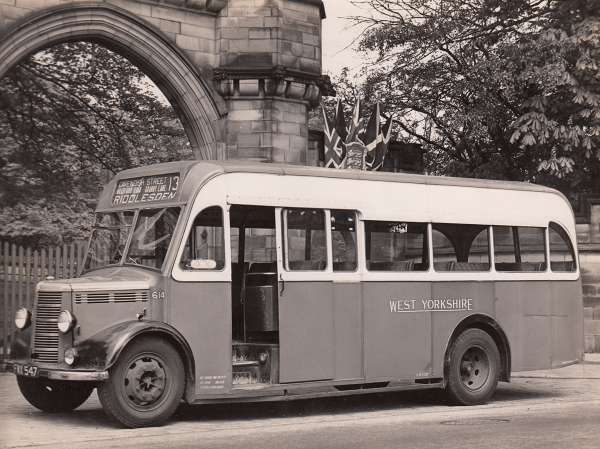
So Cliffe Castle it is! Strange location for a set of official photos. I had wondered, but on other photos, which I had assumed were a set, it appears to be Coronation year and 751, I thought, was replaced by the KSW coach in that year, 1953. You will see the flags in the background of this photo of one of the Beadle OBs. The photo has a Keighley stamp on the back. So my batch of photos must have been taken at different times.
David Rhodes
28/02/13 - 06:04
I've just stumbled across a photograph on Flickr showing one of Hardwicks Daimler/Roe DDs at Northway - at what must be the end stand near Trafalgar Street West. I hadn't realised that Hardwicks had ever used Northway, but they seem to have moved in around 1966/67 after vacating their own(?) premises at "Newhams Garage" in Victoria Road - as EYMS had by that time moved out to their premises at Westwood one assumes that their must have been vacant stand space and that WYRCC were happy to accept the departure fees . . . but it did put WYRCC in the position of providing facilities for an independent operator which competed with an associated company (Hardwicks service competed with United's service 128 between Scarborough and Ebberston). I presume Hardwicks then moved to Westwood on the closure of Northway - EYMS having by then moved to the UAS bus station on co-ordination of the Scarborough-Filey-Bridlington-Hull services.
"Newhams Garage" was one block further along Victoria Road than Brook Street. It looks to have been atypical "dormy shed" with an enquiry office to one side of the entrance. Seemingly vehicles approached along Victoria Road, swung left into Cambridge Street (opposite the garage entrance) and then reversed back across Victoria Road (B1364!) into the building (not something to be attempted without the guidance of a conductor!).
Does anybody know whether Hardwicks owned/rented these premises, or whether they were commercial premises which Hardwicks used as a terminus. Did Hardwicks ever garage vehicles in Scarborough in addition to their main garage in Snainton?
Northway was certainly more centrally-located than "Newhams Garage" and must have offered better facilities for passengers, but were there any other reasons for the move? - perhaps expiry of lease on "Newhams Garage"?
Philip Rushworth
01/03/13 - 06:50
My information regarding Hardwicks is that a service to Scarborough was started by David Hardwick in 1922 his first terminus in Scarborough was at the Castlehouse & Vasey's garage in St Thomas Street, but shortly moved to Newsham's Garage, 56 Victoria Road and continued to use this garage until 1/67 when the lease expired and the then owners Wallace Arnold did not renew it.
Hardwicks had been using this bus station/garage since 1922.
The terminus was moved to WYRCC's Northway bus station in 3/67 (which also closed some time in 1967)
Hardwicks in some form or another seemed to have used every bus station in Scarborough (except Vine Street).
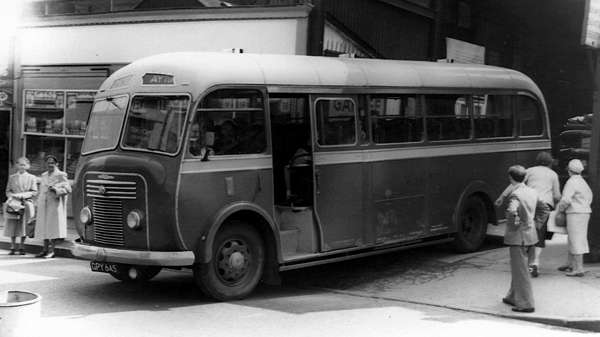 Photo shows GPY645 leaving Newsham's Garage (photograher unknown).
Photo shows GPY645 leaving Newsham's Garage (photograher unknown).
Mike Davies
01/03/13 - 07:00
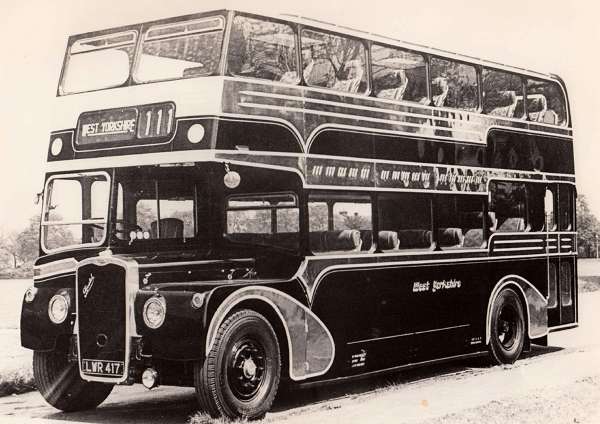
I have been hunting all week for this photo of the KSW coach when newly completed. I must say I preferred it when it was changed to the red and cream livery. This photo is quite useful because as it’s quite shiny you can see odd details, such as the hinge and catch mechanism on the n/s front wing, where it could be folded out of the way for servicing. You can also see how the seats were arranged over the rear wing, which then necessitated the raised waistline at the rear of the vehicle. You can also see how the skylights were situated. I believe this is an official WY photo.
David Rhodes
01/03/13 - 09:30
David - thanks for this incredible photo. The style seems to have been influenced by the work of US industrial designer Raymond Loewy. When I remember my feelings of claustrophobia on the upper deck of these lowbridge buses, it gives me real shivers when I see these high backs. Those seated in the middle seats upstairs must have had a very restricted view, particularly when most passengers would (presumably) be smoking throughout the journey! Much as I would have loved to travel on it, I would have camped out overnight to make sure I got a front or rear seat!
Paul Haywood
02/03/13 - 07:17
David R's photo is a brilliant one.
I'm left with one query. The transverse seats over the rear nearside wheel could not be replicated on the offside because of the sunken gangway leaving insufficient headroom. So were there any seats that side and, if so, of what type and position?
Chris Hebbron
03/03/13 - 10:42
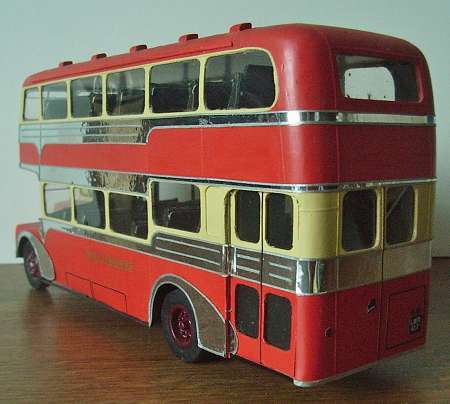
I've just come across an article on the West Yorkshire d/d coaches. I was surprised to learn that the original K6B coach wasn't converted until it was 2 years old (in 1951) and it ran as a coach for 2.5 years before reverting back to an ordinary service bus. In coach form there was seating for 41 passengers. Luggage space was provided over the back of the upper deck rear seat and over both rear wheel arches downstairs. The KSW coach originally numbered 851, later DBW 31, went straight into the workshops when delivered new and took 6 months to convert. Seating was for 51 passengers, 24 being in the lower saloon. Coach seats were fitted throughout, except for the 2 over the offside wheel arch.
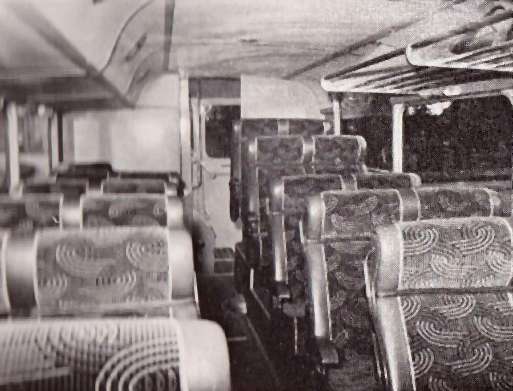
Looking at the attached photo, I get the impression that this seat on the offside was without a headrest. Six amber perspex panels were inserted into the upper deck roof. A luggage rack was fitted above the nearside seats in the lower deck, as can be seen on the attached photo. Luggage space under the stairs was accessed by a door in the rear panel. I do have photos of this, but for fear of infringing copyright I have shown this by photographing the model I made. I think the perspex roof panels in the upper deck and the removal of the sliding vents was an attempt to lighten up the top deck and overcome what some people have referred to as a claustrophobic atmosphere. The opening vents in the upper deck front windows were retained, possibly to clear out the fug caused by cigarette smoking, which was then common on the top decks of buses. The two circular details on the sides of the front indicator box were part of an air con system and electrically driven fans were housed under the stairs to draw fresh air through these circular vents.
David Rhodes
04/03/13 - 08:00
Further to John Darwents query re the A64 at Whitwell, the dualling did take place in the 1930s, opening in 1937 and the Spital Beck Inn was built at the same time to replace a pub at Barton with the same name which lost its trade when the new road was completed.
David Hick
04/03/13 - 17:44
Thx, David R for answering my question and giving us an internal glimpse of this intriguing and short-lived (as a coach)vehicle.
Chris Hebbron
19/03/14 - 17:05
I note the picture of GWX 115 leaving Scarborough (above at 15/02/13 - 06:50). As this bus was one of 10 buses using the GWX registration and based in York, why was it to be found in Scarborough. These buses were town buses, normally to be found on internal York routes, especially No.12 Strensall, No 10 Haxy etc. Why would it be used on a long distance route like York - Scarborough. Just wondered if anyone could enlighten me. I have travelled many times on GWX115 but always around York
Martin Calver
20/03/14 - 07:07
Many thanks David Hick for the info re the dualling of the A64 (4.3.2013). Sorry to be so long in acknowledging but only just visited this thread again.
John Darwent
20/03/14 - 07:08
It was not totally unusual for 'York-West Yorkshire' vehicles to be seen away from operations in the city of York and they could be seen in Scarborough operating on 'West Yorkshire' services from time to time. The buses were, visually at least, identical although I am not able to say whether their mechanical aspects and performance differed. I doubt the latter and would imagine it was just the fleetname that gave it away to anyone observant enough to realise the prefix 'York' in the title.
The use of a YWY vehicle on a WY service would probably be as a result of what vehicle might or might not be available for service at a particular time or for a duplicate at a busy time (Sunday maybe when city services required less vehicles and seaside services required more). The photograph of GWX 115 was taken in the evening sunlight so was quite likely working a duplicate on WY service 43 from Scarborough back to York.
David Slater
20/03/14 - 07:10
I worked as a Traffic clerk for WY in the Keighley Detailers office from 1963 to 1966. One of my tasks was to balance the time books, because if I remember correctly, time and vehicle mileages between the KWY and WY, and, also I think YWY and WY had to balance out in theory. I only wish that I had Chris Youhills quality of recall to clarify it further! In the early 50s it would have been quite acceptable to put such a vehicle on Scarborough on a busy weekend. After all it was a relatively modern bus by the standards of the day. For example, in the late 70s, I used a Morris Minor for every day transport. It seemed a normal thing to do. However, having recently driven one after a break of 30 years, I am shocked at how crude it is compared with a modern car. It would be wonderful to go to Scarborough on a K6B again and experience pulling into that stylish Tilling building at Northway. You never know, perhaps a double decker coach will be on the return trip!
David Rhodes
20/03/14 - 17:23
Most interesting David and, while I was aware of the "in theory" system of correct allocation of subsidiary fleet vehicles to specified routes, it was certainly not rigidly adhered to at Ilkley depot in 1960/1. I never considered in those days that "poaching" might be out of order, but we always had an allocation of two Keighley West Yorkshire double deckers for our two cars on the very very busy service 12 from Ilkley to Haworth. One in particular, KDX 40, was a Grand Prix machine with a really terrific performance in speed and in pulling power and was often to be seen on service 63 to Bradford or putting in a sparkling display on the glorious "five hours a round trip" service 76 from Skipton to Tadcaster. If any Ilkley vehicle was away for overhaul or major repair we were always lent one of KDB 54 - 57 which I liked very much. They were, however, always put on service K12 - but probably only because their traditional intermediate destination blinds couldn't show our other routes - and this was in the days before the sloppy habit of showing "West Yorkshire" or "Service" in the intermediate display.
Chris Youhill
20/03/14 - 17:24
David, I have also heard that the balancing out of mileage between WY/KWY and WY/YWY fleets was the main reason for seeing KWY and YWY buses 'out of their natural habitat'. I seem to recall York-West Yorkshire Lodekkas in Harrogate from time to time operating on the York - Harrogate 84 service in the late 'sixties, and York-West Yorkshire and York-based main fleet vehicles could also be seen operating on the short (approximately a mile) Harrogate - Woodfield 4 service around the same period. Presumably this was to make use of such vehicles on a local service rather than have them resting on layover in the bus station. I don't know if they were operated on the 4 by York or Harrogate crews however.
Brendan Smith
Please Note
It as been pointed out that there is information on two other Scarborough bus stations that maybe of interest to contributors on this thread. Here are links to view, first is the Vine Street Bus Station gallery, secondly Westwood bus station this is in the middle of an EYMS Titan thread but if and when I get the time I will try to convert the Westwood photos and comments into a separate gallery.
Comments regarding the above are more than welcome please get in touch via the 'Contact Page' or by email at obp-admin@nwframpton.com
If you have any bus related photographs that you would like to appear in a gallery on this website please send them to me by email at obp-admin@nwframpton.com
All rights to the design and layout of this website are reserved
Old Bus Photos from Saturday 25th April 2009 to Wednesday 3rd January 2024